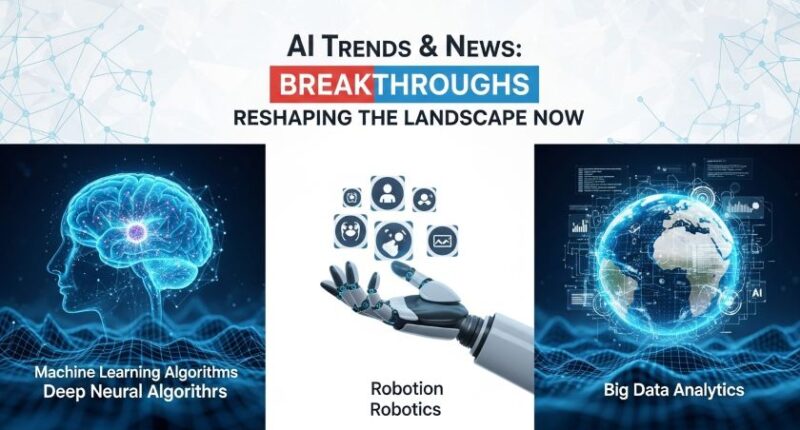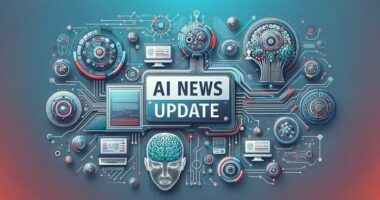In the ever‑evolving domain of artificial intelligence, November 2025 brings major landmark shifts — not just incremental upgrades. In today’s article, we highlight three fresh‑and‑urgent themes that all organisations, developers and investors should understand:
-
The rising power of AI in healthcare diagnostics and drug discovery.
-
A widening gap between model growth and hardware capability.
-
The “small is sufficient” green‑AI movement gaining traction.
Let’s explore how these trends are influencing AI strategy, innovation and markets — and what you should be watching.
AI in Healthcare: From Assistants to Lead Investigators
Diagnosing disease faster than ever
A recent report reveals that a new AI‑powered model developed in China can predict cancer gene mutations in just one minute — drastically reducing the time, cost and infrastructure needed for genotyping. CGTN News
This signals that AI is moving from assisting human experts to taking lead roles in life‑science workflows. In an article for Forbes, author William Haseltine writes that “Generative AI is now tackling preventive medicine, drug design and rapid biological insights.” Forbes
Why it matters
-
Shorter development cycles: What once required months of lab work can now be compressed into minutes or hours.
-
Broader access: Affordable AI‑powered tools may bring advanced diagnostics to regions previously underserved.
-
Shift in value‑chain: Pharma and biotech firms now must compete not just on molecule discovery, but on AI‑enabled workflow and data infrastructure.
-
Regulatory urgency: As these tools become clinically impactful, governance (FDA approvals, data privacy, audit trails) will accelerate.
Actionable take‑aways
-
If you’re in healthcare or life sciences: Assess how model‑driven genotyping, biomarker discovery or imaging AI may disrupt your domain.
-
For AI vendors: Offer not just model builds but validated pipelines, regulatory readiness and data‑integration capabilities.
-
For investors: Companies with usable AI‑bio assets, not just “AI labs”, may out‑perform in the next two‑three years.
Model Growth Outpacing Hardware: The Bottleneck Emerges
The raw numbers speak
Analysis published by IEEE Spectrum shows that model size and training volume continue to accelerate — yet hardware improvements aren’t keeping pace. The article states: “AI Model Growth Outpaces Hardware Improvements.” IEEE Spectrum
Meanwhile, benchmarking initiatives like MLCommons MLPerf reveal that training times and cost are rising even as performance gains flatten.
Why this divergence matters
-
Cost escalation: Bigger models require more compute, memory and energy — driving up capital and operational expense.
-
Infrastructure risk: Organisations betting purely on scale may hit diminishing returns or unmanageable bottlenecks.
-
Strategic trade‑off: The question shifts from “who has the biggest model?” to “who uses the model most efficiently given infrastructure constraints?”
-
Market shift: Cloud providers, chip makers and AI platforms may face pressure as margins compress or clients adopt leaner architectures.
Best‑practice insight
-
Monitor cost per token, inference latency and total cost of ownership — not just parameter count.
-
Consider domain‑specific or smaller specialist models when scale gains are marginal.
-
Infrastructure providers should highlight energy efficiency, hardware‑software co‑design and support for smaller‑footprint models as competitive advantages.
-
Researchers and product leads: Measure “value delivered / compute cost” rather than just raw capability.
The “Small Is Sufficient” Green‑AI Movement
Efficiency over ego
A new academic study titled “Small is Sufficient: Reducing the World AI Energy Consumption Through Model Selection” argues that instead of always scaling up models, choosing the right‑sized model for the task can deliver large energy savings — in some cases reducing AI energy consumption by up to 27.8 %. arXiv
This reflects a growing movement: operational sustainability and cost consciousness are becoming front‑of‑mind in AI deployments.
Implications for the ecosystem
-
Environmental positioning: Organisations citing “green AI” practices may gain brand, investor and regulatory favour.
-
Wider adoption: Smaller, efficient models expand access to organisations with limited compute budgets — democratising AI.
-
Innovation shift: Next‑gen research may emphasise efficiency, task‑matching and hybrid modelling rather than sheer scale.
-
Procurement shift: Buyers may ask not just “what model size?” but “what footprint and what outcome?”
What to do now
-
Evaluate your AI stack for “right‑sizing” opportunities: Is a 1 billion‑parameter model overkill for your use‑case?
-
Measure energy footprint and cost per inference as key procurement metrics.
-
Vendors and model providers: Market efficiency and performance per watt as key differentiators, not just parameter size.
-
Sustainability strategy: Incorporate AI energy costs, compute sourcing and model‑efficiency metrics into your ESG reports and governance frameworks.
Strategic Take‑Away: What This All Means
For enterprises deploying AI
-
Align AI investments with measurable outcomes: faster diagnostics, real‑cost reduction or energy savings.
-
Infrastructure decisions matter: Don’t just scale blindly — match to business value.
-
Governance, cost, sustainability: These levers increasingly determine success, not just novelty.
For AI infrastructure and platform providers
-
Emphasise efficiency, task‑fit and cost/resource optimisation — these are rising differentiators.
-
Support modular and smaller‑footprint models, not just “massive foundation models”.
-
Develop tooling for model‑selection, monitoring, energy‑metrics and resource‑audit — make it productised.
For investors and ecosystem watchers
-
Look for companies where AI is embedded end‑to‑end, not just in “R&D hype”.
-
Monitor margins, deployment speed and energy/compute efficiency — these may differentiate winners.
-
The era of “build the biggest model” may be waning — value and cost‑efficiency may take centre stage.
What to Watch in the Coming Weeks
-
Announcements of AI‑bio models in production environments — how many diagnostics use‑cases move from lab to real‑world.
-
Infrastructure firms releasing energy‑efficiency wins or smaller‑model support tools — signals about market direction.
-
Procurement patterns shifting to “smaller, right‑sized models” — more companies publishing compute‑footprint behaviour or efficiency metrics.
-
Regulatory or governance frameworks focusing on sustainability, auditability and resource‑use in AI (not just bias or transparency).
Final Thoughts
AI’s momentum remains undeniable — but how success will be achieved is evolving. The breakthroughs we see today are not just about bigger or faster; they are about smarter deployment, more efficient models, and measurable impact in critical domains like healthcare.
Whether you’re building, buying or investing in AI, the key questions are shifting: Which model gives the right outcome? How much compute or power will it require? And how will it deliver business or real‑world value sustainably?
In this next phase of AI, efficiency, cost‑effectiveness and application matter just as much as capability.
SEO Keywords: AI healthcare breakthrough 2025, AI model growth vs hardware, small is sufficient AI, green AI efficiency models, AI trends news November 2025









